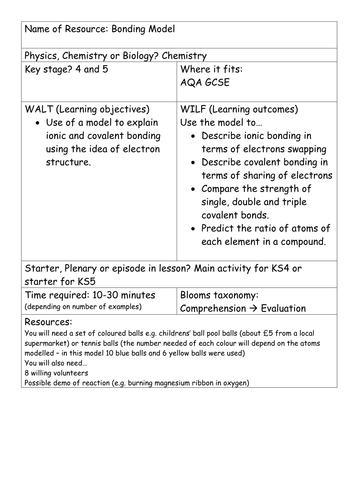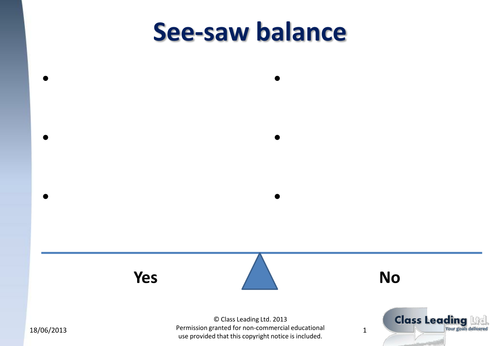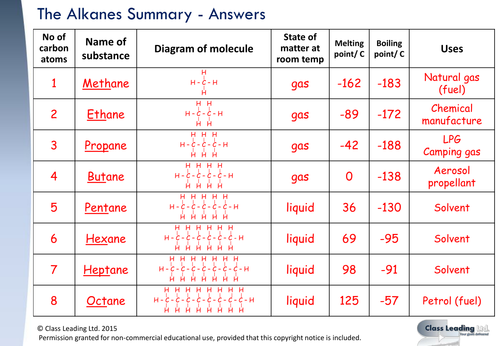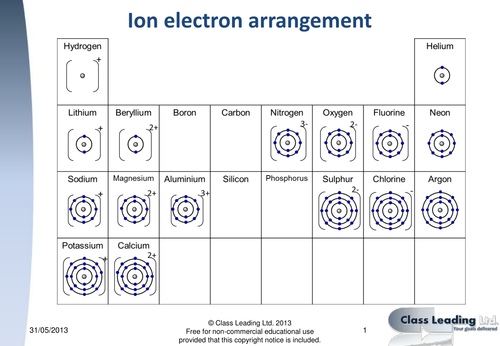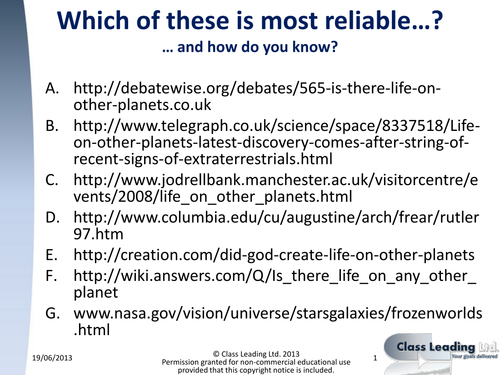314Uploads
262k+Views
194k+Downloads
Chemistry

Engaging model of ionic and covalent bonding
Keywords: bonding, model, electrons, ionic, covalent.
Notes: This engaging activity makes use of very affordable and easily available ball pool balls to support whole class teaching and group work. It models what happens to the electrons during ionic and covalent bonding.
Please note that this was originally published a number of years ago as part of the North Yorkshire Success for All project of which I was part and had the pleasure of working with an excellent team of teachers on resource development.
Right click the web links to download the powerpoint shows.

Electron structure & ionic bonding revision
Keywords: structure, bonding, electron, energy levels, shells, orbitals, rings, periodic table, patterns.
Notes: This is a revision summary sheet that has questions about structure and bonding relating to electron arrangements and ion formation.
Please note that this resource was originally designed for unit C4 of OCR 21st Century Science, but is applicable to other specifications.
It includes an answer sheet.
An editable premium version is available at: https://www.tes.com/teaching-resource/-13142395

The Carbon Cycle - Extracting info from a text
Keywords: Carbon cycle, photosynthesis, respiration, decomposition, combustion.
An activity sheet and guidance sheet (with answers highlighted) in which students extract information from a text and then use this to identify the processes in the carbon cycle and ultimately construct a diagram from these. These can then be compared to one published in a textbook to allow students to make corrections. This works exceptionally well as a peer assessed activity.

The carbon cycle - grade questions
This activity contains a powerpoint with graded questions & answers and matching pupil activity sheets, designed to be used at the end of a lesson and/or the start of the next lesson to review previous learning. The questions are based on the previous OCR 21st Century Science Specification unit P2, although could be used with other exam boards.\nClicking through the show reveals answers one a time. These reduce to A5 easily, the ideal size for most pupils. Please note grades are approximate.

Weighing up arguments - See saw writing frame
This resource is a collection of 6 slightly different see-saw balances that can be used with learners to help them develop the skills to weigh up an argument. The idea is that students will list reasons on both side of an argument (e.g. Should we have Nuclear Power?). They then use this to help make a decision. The scoring column on some sheets allows learners to score each argument out of a maximum of say 3. Add the scores on each side to see which has the stronger argument. This also includes phrases to support a more detailed conclusion. This was inspired by 21st Century Science.

The Alkanes Summary (flipped learning)
This is a collection of separate pdf documents that help learners summarise information about the alkanes.
Each of the different sheets allows for a different level of support and challenge
- Sheet A is totally blank.
- Sheets B and C have fewer sections to fill in.
- Sheet D has all of the molecules drawn.
- Sheets E involves some reading for information and only has a limited amount of information and could be good for the least able.
- Sheet F, many of the answers can be deduced (at least approximately) and can be good for stretching the most able.
It is intended that the activity be carried out as 'flipped learning' so that learners complete this activity before learning about the alkanes and/or fractional distillation.

Reactivity of metals timeline (starter)
Keywords: metal, reactivity, extraction
A short activity (starter?) to encourage higher order thinking and identify relationship between reactivity of metals and their date of first extraction.
Please note that this was originally published a number of years ago as part of the North Yorkshire Success for All project of which I was part and had the pleasure of working with an excellent team of teachers on resource development.
Included is the original briefing sheet and a powerpoint slideshow

Evidence for climate change - data handling
This is a short standalone activity linked with the topic of climate change, global warming and icecap melting. It is intended to develop higher-order thinking skills and understanding of data. It aims to provide an opportunity for cognitive conflict and discussion.
There are two ways this task can be attempted:
Allow the students to work through the first two set of tasks sequentially. Hand out only the sheet with a triangle in the top right of the page. When this is completed, hand out only the sheet with the square. Finally, when this is completed give out the third and final sheet with questions 4 onwards.
Alternatively…
One half of class is given the first sheet, marked with a triangle. The other half is given the ones marked with a square. Pupils work on their own sheets independently. After a few minutes, pupils who have completed different sheets pair up. They compare their sheets and answer the questions on the third sheet together.
When this was tested, pupils responded well to the tricky questions.

Electron arrangements for ions
Keywords: ionic, ions, electron, shell, energy level, orbitals, rings, periodic table.
This resource contains an animated powerpoint show and two sheets. These can be used as a revision tool or as an independent learning resource to help students explore and spot patterns in ion formation in the periodic table. Please note that there is a similar resource showing the electron arrangement for the first 20 elements
Right click the web links to download the powerpoint shows.

Properties of materials - graded questions
This activity contains a powerpoint with graded questions & answers and matching pupil activity sheets, designed to be used at the end of a lesson and/or the start of the next lesson to review previous learning. The questions are based on the previous OCR 21st Century Science Specification unit C2, although could be used with other exam boards.\nClicking through the show reveals answers one a time. These reduce to A5 easily, the ideal size for most pupils. Please note grades are approximate.

Evaluating websites from URLs
This resource is a short powerpoint show and a pdf of the first slide. The idea is that learners read the URLs for a series of websites and decide whether they are trustworthy. They could put them into one of say three categories (e.g. High, Medium. Low).This is great for stimulating debate amongst learners, especially if the task is completed as a group. It is very effective when learners are asked to explain their reasoning. The powerpoint show can then be used to develop understanding further.

Ionic theory - graded questions
This activity contains a powerpoint with graded questions & answers and matching pupil activity sheets, designed to be used at the end of a lesson and/or the start of the next lesson to review previous learning. The questions are based on the previous OCR 21st Century Science Specification unit C4, although could be used with other exam boards.\nClicking through the show reveals answers one a time. These reduce to A5 easily, the ideal size for most pupils. Please note grades are approximate.

Atoms, ions & molecules - graded questions
This activity contains a powerpoint with graded questions & answers and matching pupil activity sheets, designed to be used at the end of a lesson and/or the start of the next lesson to review previous learning. The questions are based on the previous OCR 21st Century Science Specification unit C4, although could be used with other exam boards.\nClicking through the show reveals answers one a time. These reduce to A5 easily, the ideal size for most pupils. Please note grades are approximate.

Properties of salts - graded questions
This activity contains a powerpoint with graded questions & answers and matching pupil activity sheets, designed to be used at the end of a lesson and/or the start of the next lesson to review previous learning. The questions are based on the previous OCR 21st Century Science Specification unit C4, although could be used with other exam boards.\nClicking through the show reveals answers one a time. These reduce to A5 easily, the ideal size for most pupils. Please note grades are approximate.

Atomic structure - graded questions
This activity contains a powerpoint with graded questions & answers and matching pupil activity sheets, designed to be used at the end of a lesson and/or the start of the next lesson to review previous learning. The questions are based on the previous OCR 21st Century Science Specification unit C4, although could be used with other exam boards.\nClicking through the show reveals answers one a time. These reduce to A5 easily, the ideal size for most pupils. Please note grades are approximate.

Atoms into ions - graded questions
This activity contains a powerpoint with graded questions & answers and matching pupil activity sheets, designed to be used at the end of a lesson and/or the start of the next lesson to review previous learning. The questions are based on the previous OCR 21st Century Science Specification unit C4, although could be used with other exam boards.\nClicking through the show reveals answers one a time. These reduce to A5 easily, the ideal size for most pupils. Please note grades are approximate.

The Halogens
This activity contains a powerpoint with graded questions & answers and matching pupil activity sheets, designed to be used at the end of a lesson and/or the start of the next lesson to review previous learning. The questions are based on the previous OCR 21st Century Science Specification unit C4, although could be used with other exam boards.\nClicking through the show reveals answers one a time. These reduce to A5 easily, the ideal size for most pupils. Please note grades are approximate.

Atomic structure periodic table - graded questions
This activity contains a powerpoint with graded questions & answers and matching pupil activity sheets, designed to be used at the end of a lesson and/or the start of the next lesson to review previous learning. The questions are based on the previous OCR 21st Century Science Specification unit C4, although could be used with other exam boards.\nClicking through the show reveals answers one a time. These reduce to A5 easily, the ideal size for most pupils. Please note grades are approximate.

Molecules by design - graded questions
This activity contains a powerpoint with graded questions & answers and matching pupil activity sheets, designed to be used at the end of a lesson and/or the start of the next lesson to review previous learning. The questions are based on the previous OCR 21st Century Science Specification unit C2, although could be used with other exam boards.\nClicking through the show reveals answers one a time. These reduce to A5 easily, the ideal size for most pupils. Please note grades are approximate.

Testing materials - measuring - graded questions
This activity contains a powerpoint with graded questions & answers and matching pupil activity sheets, designed to be used at the end of a lesson and/or the start of the next lesson to review previous learning. The questions are based on the previous OCR 21st Century Science Specification unit C2, although could be used with other exam boards.\nClicking through the show reveals answers one a time. These reduce to A5 easily, the ideal size for most pupils. Please note grades are approximate.

